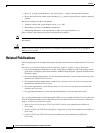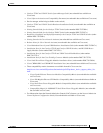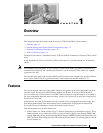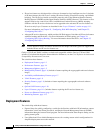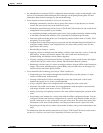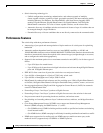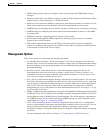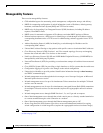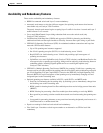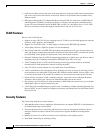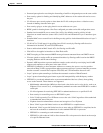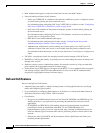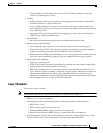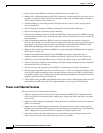
1-5
Catalyst 3750-E and 3560-E Switch Software Configuration Guide
OL-9775-02
Chapter 1 Overview
Features
• IGMP snooping querier support to configure switch to generate periodic IGMP General Query
messages
• Multicast Listener Discovery (MLD) snooping to enable efficient distribution of IP Version 6 (IPv6)
multicast data to clients and routers in a switched network.
• Multicast VLAN registration (MVR) to continuously send multicast streams in a multicast VLAN
while isolating the streams from subscriber VLANs for bandwidth and security reasons
• IGMP filtering for controlling the set of multicast groups to which hosts on a switch port can belong
• IGMP throttling for configuring the action when the maximum number of entries is in the IGMP
forwarding table
• IGMP leave timer for configuring the leave latency for the network
• Switch Database Management (SDM) templates for allocating system resources to maximize
support for user-selected features
• Web Cache Communication Protocol (WCCP) for redirecting traffic to wide-area application
engines, for enabling content requests to be fulfilled locally, and for localizing web-traffic patterns
in the network (requires the IP services image)
Management Options
These are the options for configuring and managing the switch:
• An embedded device manager—The device manager is a GUI that is integrated in the universal
software image. You use it to configure and to monitor a single switch. For information about starting
the device manager, see the getting started guide. For more information about the device manager, see
the switch online help.
• Network Assistant—Network Assistant is a network management application that can be
downloaded from Cisco.com. You use it to manage a single switch, a cluster of switches, or a
community of devices. For more information about Network Assistant, see Getting Started with
Cisco Network Assistant, available on Cisco.com.
• CLI—The Cisco IOS software supports desktop- and multilayer-switching features. You can access
the CLI by connecting your management station directly to the switch console port, by connecting
your PC directly to the Ethernet management port, or by using Telnet from a remote management
station or PC. You can manage the switch stack by connecting to the console port or Ethernet
management port of any stack member. For more information about the CLI, see Chapter 2, “Using
the Command-Line Interface.”
• SNMP—SNMP management applications such as CiscoWorks2000 LAN Management Suite (LMS)
and HP OpenView. You can manage from an SNMP-compatible management station or a PC that is
running platforms such as HP OpenView or SunNet Manager. The switch supports a comprehensive
set of MIB extensions and four remote monitoring (RMON) groups. For more information about
using SNMP, see Chapter 33, “Configuring SNMP.”
• CNS—Cisco Networking Services is network management software that acts as a configuration
service for automating the deployment and management of network devices and services. You can
automate initial configurations and configuration updates by generating switch-specific
configuration changes, sending them to the switch, executing the configuration change, and logging
the results.
For more information about CNS, see Chapter 4, “Configuring Cisco IOS CNS Agents.”




